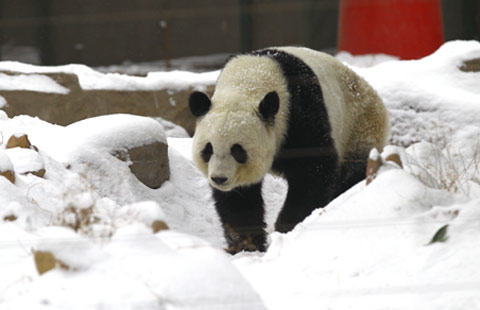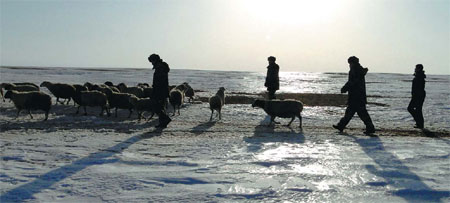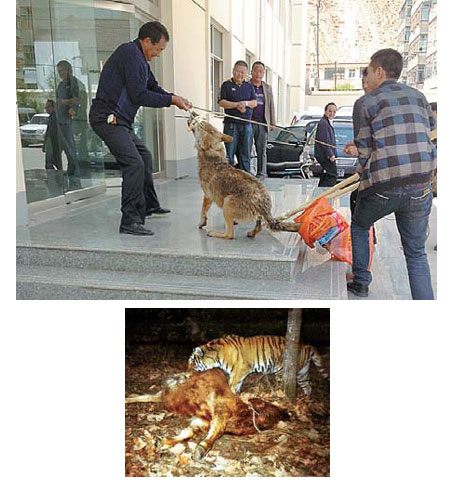Creatures of habitat
Updated: 2014-03-02 07:48
By Erik Nilsson (China Daily)
|
|||||||||||
Governments and NGOs are innovating resolutions to conservation controversies that arise between endangered species and people who share the land with them. Erik Nilsson reports.
The government has cooked up a solution to elephants plundering the crops upon which farmers depend in Yunnan's Xishuangbanna - a giant "canteen" for the massive mammals.
The hope is the planned 260-hectare plot of equal parts bamboo and bananas will provide an alternative food source for the animals that devour yields in Pu'er city's Simao district, where farmers' fields make for easy pickings for the 38 pachyderms that roam the rainforests.
Yet the canteen is but one answer to China's human-wildlife conflicts that successful conservation exacerbates. Governments and NGOs are conjuring innovative techniques to allay such clashes around the country.
Armed police are escorting livestock in the Inner Mongolia autonomous region's Xilin Gol League, where wolves killed more than 1,000 livestock animals in 2011, causing nearly 1 million yuan ($157,480) in losses.
The International Fund for Animal Welfare worked with the Beijing Forestry Bureau to establish a compensation scheme for poultry farmers whose fowl are taken by raptors. It's the first local regulation of its kind in an urban center, the IFAW says.
The World Wildlife Fund released deer into Jilin province's Wangqing Natural Reserve in 2012 in hopes of reducing Siberian tiger attacks on livestock.
"We hope the wild tigers will prey on the deer," WWF's Northeast Program Office director Zhu Jiang explains.
Zhu says many deer that seem to have been killed by tigers or leopards have been discovered in the area.
"This indicates we can sustain the species by increasing the population of their quarry," he says.
Lang Jianmin, an official from Jilin's Hunchun National Siberian Tiger Nature Reserve, points out the growth in the species' number is partly due to humans - that is, livestock make easy meals for the creatures.
Siberian tigers are one of the world's rarest species. Only 12 to 16 lived in China's wilds in 2000. The number had increased to 18 to 22, the State Forestry Administration announced last May. The government hopes to make that about 40 by 2022.
"Eating livestock may cause the tigers to become more domesticated and ruin their relationship with local residents," Lang says.
Jilin's government paid 38 million yuan ($6 million) to reimburse costs from 13,811 wild animal incidents between 2006 and 2012.
The IFAW has complemented the government's efforts in Xishuangbanna with programs to develop alternative economies less dependent on crops, create monitoring networks to alert villagers to elephants' movements and research alternative food sources for the animals.
It has initiated a micro-credit scheme to help villagers shift to different livelihoods to reduce their dependence on the land they share with the pachyderms.
"Our project further motivated local governments and the private sector support to explore other ways of mitigating human-wildlife conflict," the IFAW's Asia regional director Grace Ge Gabriel explains.
"For example, in many communities in Yunnan, the government buys insurance for farming communities to insure their crops."
The government started purchasing insurance in 2011, when residents received 3.24 million yuan in compensation for losses from elephants, Simao district's forestry bureau head Li Yichuan explains.
There were 231 reported instances of damage caused by elephants in 2012, when compensation reached 4.2 million yuan.
Ge Gabriel also voices hope for the canteen.
Investment will total 2.6 million yuan, the forestry bureau says.
About 26.7 hectares each of bananas and bamboo will be planted in the first stage.
Li says: "This way, we can make sure elephants have enough to eat and they will interfere less in local people's lives."
Contact the writer at erik_nilsson@chinadaily.com.cn
Xinhua contributed to this story.
|
Armed police escort livestock in the Inner Mongolia autonomous region's Xilin Gol League. Zou Jianpu / Xinhua |
|
Top: A wolf is caught after it runs into an office building in Huangnan Tibetan autonomous prefecture in Qinghai province. Provided to China Daily Above, at top: A wild Siberian tiger attacks livestock in a pasture in Huichun city of Jilin province. Re Xue / for China Daily |
|
Top: A wild bear is caught and saved after it drops into a pond in Xiangshuidong village, Yidu city, in Hubei province. Cao Lida / for China Daily Above, at bottom: Villagers of Mengla county of Yunnan province check a banana field ruined by wild elephants. Li Yunsheng / for China Daily |
(China Daily 03/02/2014 page3)
Today's Top News
Putin not yet decided on use of force in Ukraine
28 dead in Kunming violence
China, UK hold dialogue on ties
Ukraine protests over airspace violation
Perrin takes on China's soccer team
China grills US in human rights report
Perrin takes on China's soccer team
Armed men seize govt HQ in Ukraine's Crimea
Hot Topics
Lunar probe , China growth forecasts, Emission rules get tougher, China seen through 'colored lens', International board,
Editor's Picks

|

|

|

|

|

|








